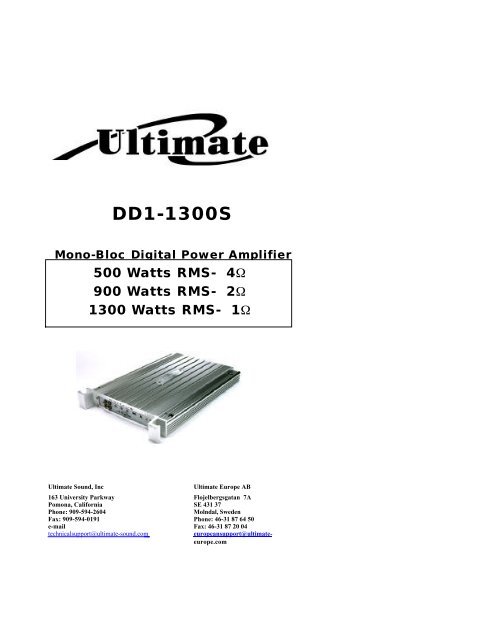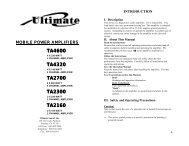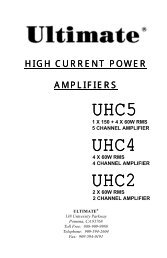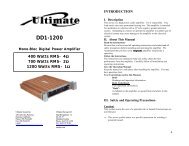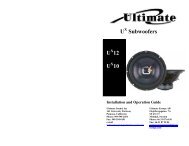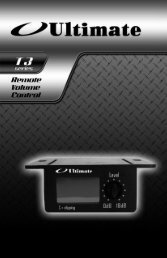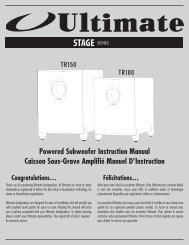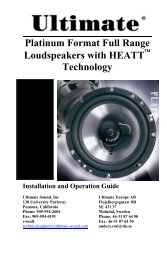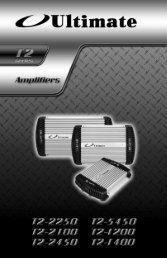Digitalis DD1-1300S - Ultimate Sound
Digitalis DD1-1300S - Ultimate Sound
Digitalis DD1-1300S - Ultimate Sound
You also want an ePaper? Increase the reach of your titles
YUMPU automatically turns print PDFs into web optimized ePapers that Google loves.
<strong>DD1</strong>-<strong>1300S</strong><br />
Mono-Bloc Digital Power Amplifier<br />
500 Watts RMS- 4<br />
900 Watts RMS- 2<br />
<strong>Ultimate</strong> <strong>Sound</strong>, Inc.<br />
1300 Watts RMS- 1<br />
<strong>Ultimate</strong> Europe AB<br />
<strong>Ultimate</strong> <strong>Sound</strong>, Inc<br />
<strong>Ultimate</strong> Europe AB<br />
163 University Parkway Flojelbergsgatan 7A<br />
Pomona, California SE 431 37<br />
Phone: 909-594-2604<br />
Molndal, Sweden<br />
Fax: 909-594-0191 Phone: 46-31 87 64 50<br />
e-mail Fax: 46-31 87 20 04<br />
technicalsupport@ultimate-sound.com<br />
europeansupport@ultimateeurope.com
INTRODUCTION<br />
I. Description<br />
This device is a high power, audio amplifier. Use it responsibly. Very<br />
loud music can cause permanent hearing loss. This amplifier is intended for<br />
installation in vehicles with a 12 Volt, negative ground electrical system.<br />
Attempting to connect or operate the amplifier in another type of electrical<br />
system may cause damage to the amplifier or the electrical system.<br />
II. About This Manual<br />
Read the Instructions-<br />
Be sure that you have read all operating instructions and understand all<br />
safety precautions before installing and operating the amplifier. We<br />
recommend that you have your <strong>Digitalis</strong> amplifier installed by a<br />
specialist.<br />
Follow the Instructions-<br />
The instructions are intended to help you safely obtain the best performance<br />
from the amplifier. Carefully follow all installation and operating<br />
instructions.<br />
Save the Operating Manual-<br />
Keep the manual in a safe place after installing the amplifier. You may have<br />
questions later.<br />
Text Conventions used in this Manual-<br />
Bold-<br />
Headings and important information.<br />
Bold, Underlined-<br />
Very important information.<br />
"Bold"-<br />
As labeled on the amplifier, or quoted from elsewhere in this<br />
manual.<br />
III. Safety and Operating Precautions-<br />
Caution!<br />
This symbol warns the user of a potential risk or hazard if instructions are<br />
not followed.<br />
⇒ This arrow symbol points to a specific instruction for avoiding a<br />
potential hazard.<br />
ii
1. Installation<br />
1.1 Installation- Mounting the Amplifier<br />
Step 1- Disconnect the negative (-) battery cable before mounting the<br />
amplifier or making any connections. Check the battery and alternator<br />
ground (-) connections. Make sure they are properly connected and free of<br />
corrosion<br />
Step 2- Choose a mounting location for your amplifier. Find a location on<br />
a flat surface away from heat and moisture. Be sure the mounting location<br />
and the drilling of pilot holes for mounting will not present a hazard to any<br />
wires, control cables, fuel lines, fuel tanks, hydraulic lines, or other vehicle<br />
systems or components. Common mounting locations are under the front<br />
passenger seat, or in the trunk area. Choose a location with unimpaired air<br />
circulation. The amplifier will dissipate heat more efficiently if mounted<br />
vertically.<br />
Step 3- Place the amplifier in the mounting location, and mark the<br />
positions of the holes with a marker, pen or pencil. Carefully drill the<br />
mounting holes in the marked positions.<br />
Caution!<br />
⇒ Check carefully before drilling any pilot holes.<br />
Step 4- Use the supplied mounting screws to securely fasten the amplifier<br />
to the mounting surface. Wrap the screw driver shaft with electrical tape to<br />
avoid marring the area around the mounting holes.<br />
1.2 Installation- Power Connections<br />
Step 1- Run a power cable from the battery to the amplifier mounting<br />
location. Use rubber grommets to protect the cable anywhere it has to go<br />
through metal. Use #4 AWG or larger power and ground cable.<br />
Step 2- Connect one end of an in-line fuse holder to the power cable.<br />
Connect the other end of the fuse holder to the positive battery post with 20<br />
cm (or less) of the same cable. This fuse location will protect the system<br />
and the vehicle against the possibility of a short circuit in the power cable.<br />
Be sure to use a fuse and fuse holder adequate for the application. Do not<br />
place a fuse in the holder at this time.<br />
The maximum fuse rating for the <strong>Digitalis</strong> <strong>DD1</strong>-<strong>1300S</strong> is:<br />
3 X 40 Amps<br />
Caution!<br />
⇒ Bridging fuses or replacing a fuse with one of a higher rating may<br />
cause damage to the amplifier and the vehicle's electrical system.<br />
1
Step 3- Run a remote turn on cable from the switched +12V source you<br />
will be using to turn on the system components. This may be a toggle<br />
switch, a relay, or your source unit’s remote trigger wire, or power antenna<br />
trigger wire. Run this lead to the amplifier mounting location. Use #18<br />
AWG wire or larger.<br />
Step 4- Locate a secure grounding connection as close to the amplifier as<br />
possible. Make sure the location is clean and provides a direct electrical<br />
connection to the frame of the vehicle. Connect one end of a short piece of<br />
the same size cable as the power cable to the grounding point. Run the<br />
other end of the cable to the amplifier mounting location.<br />
Step 5- connect the ground cable to the screw terminal labeled “POWER,<br />
GND”.<br />
Step 6- Connect the power cable to the amplifier at the screw terminal<br />
labeled “POWER, BATT”.<br />
Step 7- Connect the remote turn on cable to the screw terminal labeled<br />
“POWER, REM”.<br />
1.3 Installation- Speaker Connections<br />
Step 1- Run #14 AWG or larger connecting wire from your speakers to the<br />
amplifier mounting location. Keep speaker wires away from power cables<br />
and amplifier input cables. Use grommets anywhere the wires have to pass<br />
through holes in the metal frame or sheet metal. Connect to the speakers<br />
according to the type of terminals on each speaker.<br />
Step 2- Strip 3/8" of insulation from the end of each wire and twist the<br />
wire strands together tightly. Make sure there are no stray strands that<br />
might touch other wires or terminals and cause a short circuit.<br />
Step 3- If possible, tin the wire ends with solder to provide a secure<br />
termination.<br />
Step 4- Connect the wire ends to your amplifier as follows:<br />
SPEAKER<br />
- + - +<br />
SPEAKER TERMINALS<br />
Follow the (+) (-) polarity markings,<br />
making sure they match the polarity of the<br />
connections at the speakers. There are 2<br />
sets of (+) and (-) terminals for<br />
convenience in connecting multiple<br />
subwoofers.<br />
2
MULTIPLE SPEAKER CONNECTION<br />
PARALLEL- Each additional speaker decreases the load impedance<br />
for the amplifier. The amplifier delivers more current and works<br />
harder.<br />
PARALLEL CONNECTION USING 4 OHM SPEAKERS<br />
4 Ohm 2 Ohm<br />
A<br />
M<br />
O<br />
P<br />
U<br />
L<br />
T<br />
I<br />
P<br />
F<br />
U<br />
I<br />
T<br />
E<br />
R<br />
+<br />
-<br />
(+)<br />
(-)<br />
(+)<br />
(-)<br />
SERIES- Each additional speaker increases the load impedance for<br />
the amplifier. Impedances higher than 8 ohms are rarely used for car<br />
audio.<br />
SERIES CONNECTION USING 4 OHM SPEAKERS<br />
4 Ohm 8 Ohm<br />
A<br />
M<br />
O<br />
P<br />
U<br />
L<br />
T<br />
I<br />
P<br />
F<br />
U<br />
I<br />
T<br />
E<br />
R<br />
+<br />
-<br />
(+)<br />
(-)<br />
(+)<br />
(-)<br />
LINE<br />
OUT<br />
LINE<br />
INPUT<br />
1.5 Installation- Input<br />
Connections<br />
Low Level, High Impedance, Gold Plated RCA Input<br />
and Output Jacks-<br />
Connect the input jacks to a source providing preamp level<br />
outputs. Use heavy duty RCA patch cords designed for<br />
mobile applications . Run the patch cables carefully,<br />
3
maintaining as much distance as possible from power, speaker, and<br />
accessory wiring. Make sure the RCA plugs fit tightly for a secure<br />
connection.<br />
Connect the output jacks to any component that can accept preamp level<br />
inputs.<br />
1.6 Installation- Check all Connections<br />
Recheck all connections before reconnecting the negative(-) battery cable.<br />
Insert the correct value fuse in the fuse holder at the battery before<br />
attempting to turn on the system.<br />
2. Operation<br />
2.1 Operation- Input Level adjustments<br />
LEVEL<br />
Adjust the control marked “LEVEL” to control the input<br />
sensitivity of the <strong>DD1</strong>-<strong>1300S</strong> Turn clockwise to increase the<br />
level, counter clockwise to decrease. Amplifiers will run cooler<br />
and produce less system noise at lower level settings.<br />
MIN MAX<br />
Consult an experienced installation specialist for assistance in<br />
balancing the levels in multi-amplifier systems, or systems<br />
with signal processing accessories.<br />
2.2 Operation- Variable Subsonic Filter<br />
The subsonic filter protects your subwoofers from over excursion at<br />
frequencies that might damage your subwoofers. The frequency is variable<br />
from 15Hz to 50Hz, and the slope is 24dB/Octave<br />
2.3 Operation- Bass Boost, Remote Bass<br />
Boost-<br />
BASS<br />
BOOST<br />
0dB<br />
18dB<br />
Turning the “BOOST” control clockwise increases the level<br />
of frequencies around 45Hz by up to 18dB when fully<br />
clockwise. Plugging in the remote control module overrides<br />
the on-board control for remote operation and adjustment. The<br />
remote plug –in jack is located next to the speaker terminal<br />
block. You can mount the remote control on any flat surface,<br />
but it is most commonly secured under the dash, or in the<br />
center console of the vehicle. Use the supplied screws to mount the remote<br />
control housing.<br />
4
2.4 Operation- Built-in Crossover<br />
The <strong>Digitalis</strong> <strong>DD1</strong>-<strong>1300S</strong> has a built-in crossover filter for low-pass<br />
operation. The filter slope is 24 dB/Octave.<br />
FREQ<br />
50HZ 250HZ<br />
FREQUENCY ADJUSTMENT<br />
Adjust the low pass frequency by turning the control marked<br />
“FREQ, 50Hz – 250Hz". Turn clockwise to set to a higher<br />
frequency, counter clockwise to set to a lower frequency.<br />
2.5 Operation- Phase Control<br />
The “PHASE” switch changes the phase of the output 180 degrees when<br />
switched on. This allows quick phase adjustment to match the phase of<br />
subwoofers to the main speakers for better stereo imaging and bass response.<br />
2.6 Operation- Protection Circuits and<br />
L.E.D. Indicators<br />
L.E.D. INDICATOR- The green LED lights to<br />
provide a visual indication that the amplifier is<br />
POWER PROTECT<br />
turned on. The red LED lights to indicate that a<br />
problem exists and the protection circuitry has<br />
protected the amplifier by shutting it down. Turn the system off and correct<br />
the problem before turning the system on.<br />
THERMAL PROTECTION- The amplifier will shut down if its<br />
temperature exceeds a safe operating level. The amplifier will remain off<br />
until it cools to a safe operating temperature. Exercise care, the exterior of<br />
the amplifier may get uncomfortably hot to the touch before shutting down.<br />
OVERLOAD AND SHORT CIRCUIT PROTECTION- The amplifier<br />
will shut down if a short circuit condition exists, or if electrical current<br />
demands exceed safe levels.<br />
FUSES<br />
40A<br />
FUSE PROTECTION- A blown fuse indicates a<br />
problem that should be corrected before the fuse is<br />
replaced. Always replace with the same value fuse.<br />
Never substitute a larger value fuse.<br />
5
2.4 Operation- Location of Terminals,<br />
Controls and LED indicators<br />
1. RCA input jacks 2. RCA output jacks 3. Input level adjust<br />
4. Subsonic freq. 5. Low pass freq. 6. Phase switch<br />
7. Bass Boost 8. Power LED 9. Protect LED<br />
DIGITALIS<br />
LINE<br />
OUT<br />
LINE<br />
INPUT<br />
LEVEL<br />
SUB<br />
SONIC<br />
FREQ<br />
PHASE<br />
BASS<br />
BOOST<br />
MIN MAX<br />
0 - 18dB 50HZ 250HZ<br />
0 - 180<br />
0dB<br />
18dB<br />
POWER<br />
PROTECT<br />
1 2 3 4 5 6 7 8 9<br />
1. Speaker terminals 2. Remote Jack 3. Fuse(s)<br />
4. Power terminals<br />
SPEAKER<br />
REMOTE<br />
FUSE<br />
POWER<br />
40A<br />
40A<br />
40A<br />
- + - +<br />
BATT GND REM<br />
1 2 3 4<br />
6
Features and Specifications:<br />
<strong>DD1</strong>-<strong>1300S</strong><br />
1 Stable Yes<br />
Mono-bloc Yes<br />
Terminals Gold plated RCA jacks, speaker and power terminals<br />
Soft Start<br />
Yes<br />
Inputs<br />
RCA line level inputs<br />
Crossover<br />
Low Pass, 24dB/Octave, 50Hz – 250Hz<br />
Subsonic<br />
Filter<br />
15Hz – 50Hz, 24dB/Octave<br />
Bass Boost<br />
Variable, Remote, 0 to 18dB @ 45Hz<br />
Protection<br />
Thermal, short-circuit, DC offset, fuse<br />
Power<br />
Supply<br />
Pulse Width Modulated, MOSFET power supply,<br />
+12V/Negative Ground<br />
Power, 4 , 500 Watts RMS
Troubleshooting:<br />
Condition Possible Cause Possible Solution<br />
No sound<br />
Amplifier<br />
shut down<br />
Distortion<br />
Poor bass<br />
response<br />
Ticking<br />
noise<br />
Whining<br />
noise<br />
Low or no remote turn<br />
on voltage, or no remote<br />
turn on connection<br />
Blown fuse(s)<br />
Wiring problems<br />
Blown speakers<br />
Protection circuit<br />
protecting against<br />
overheating or overload<br />
Input level not properly<br />
adjusted<br />
Speaker damage<br />
Speakers out of phase<br />
Radiated noise from<br />
spark plug wires<br />
Alternator noise caused<br />
by poor grounding of<br />
amplifier, source, other<br />
component, battery, or<br />
alternator<br />
Check the remote turn on<br />
connection and the voltage at<br />
the amplifier and source unit<br />
Check all system fuses<br />
Recheck all connections<br />
Check for short circuits<br />
Check speakers on another<br />
amplifier<br />
Check for adequate ventilation<br />
Check load impedance<br />
Check speaker wiring for short<br />
to the vehicle chassis<br />
Reduce input level<br />
Readjust amplifier input level<br />
Check speakers on another<br />
amplifier<br />
Recheck speaker wiring<br />
Reverse polarity of one speaker<br />
Reroute amplifier input wiring<br />
Install a noise filter<br />
Check all ground connections<br />
Install a noise filter on the<br />
source unit’s power cable<br />
Install a coupling transformer<br />
in the signal path to improve<br />
ground isolation for the signal<br />
path<br />
8


